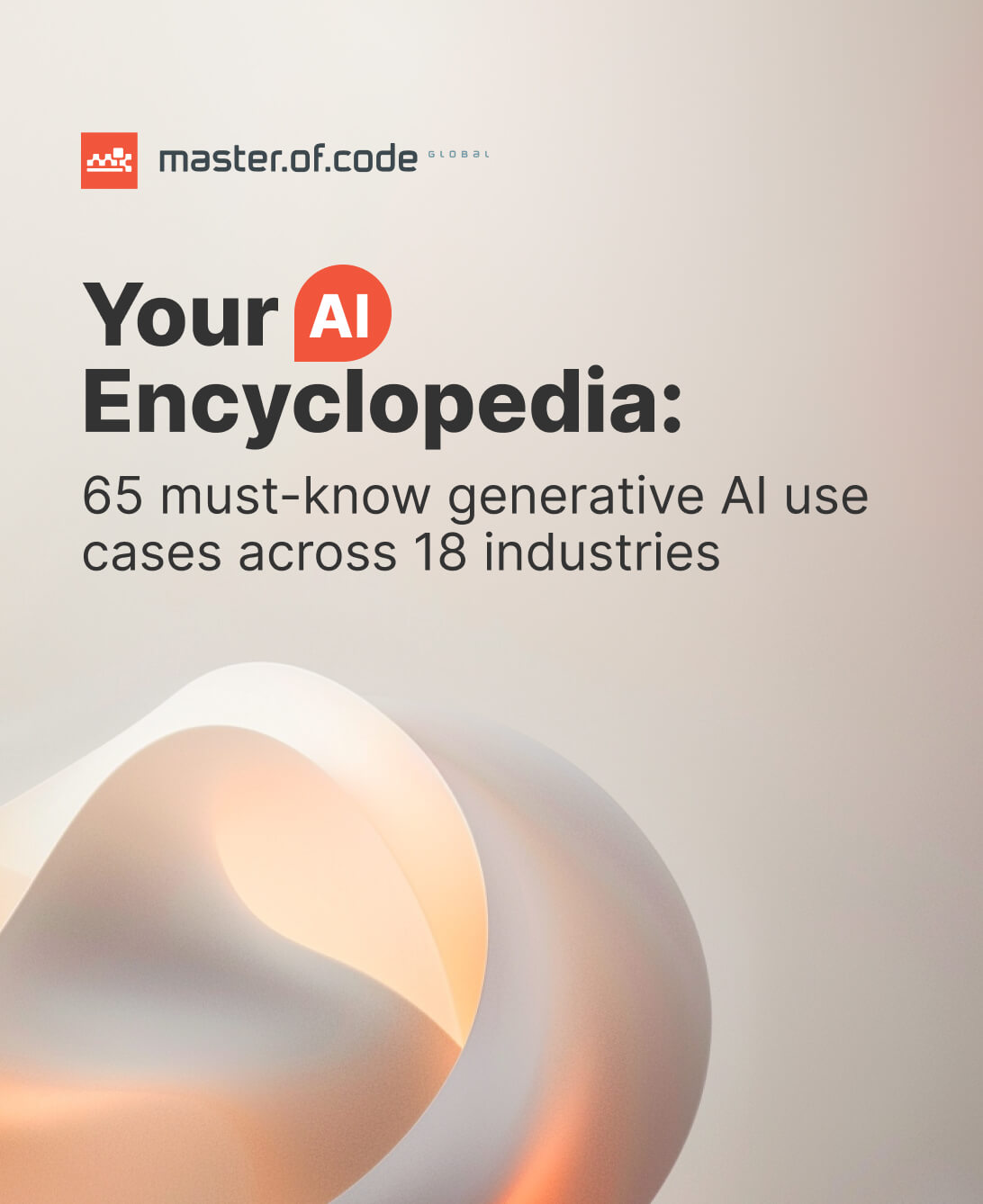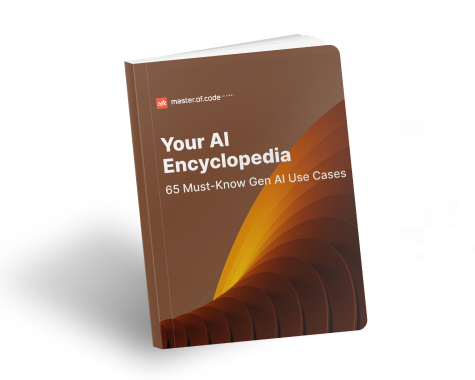Who doesn’t enjoy sports? Chances are, less than 1% of people worldwide have no interest in them. From football and cricket to tennis, basketball, rugby, and golf, these games attract fanbases ranging from 450 million to over 3.5 billion people.
But what does artificial intelligence have to do with sports?
Surprisingly, it’s already playing a major role. From performance analysis and personalized training plans to injury prevention and next-level experiences, AI is shaping how these are played, managed, and enjoyed.
For business leaders, the real question is: “Should I invest in Generative AI in sports?” The answer isn’t always straightforward. In fact, it hinges on more than just the technology itself. In the sections ahead, we’ll walk through the 5 key considerations, so you can decide if, when, and how to invest with clarity and confidence.
Table of Contents
Consideration #1: How Big Is the GenAI in Sports Opportunity?
The first thing to acknowledge is that the technology has definitely moved past simple experimentation. In 2024, Generative AI in the sports market reached USD 1.03 billion and is projected to grow to USD 2.61 billion by 2030 at a 16.7% CAGR. This means businesses are actively investing in this innovation.
You can already see its impact in widely accepted solutions:
- Video Assistant Referee (VAR): Introduced for the 2018 FIFA World Cup, now used in 100+ competitions worldwide. AI in VAR cameras automatically detect fouls, offsides, and handballs in real time. 54% of sports fans find VAR useful.
- Field or Court Line Technology: GPS, laser-guided, and AR line-marking tools, often AI-enhanced, improve accuracy, safety, and efficiency. 53% of consumers value this implementation.
- Game Data Apps: Backed by machine learning (ML), platforms like ESPN, FIFA+, and NFL Game Pass provide real-time updates, predictive analytics, and player comparisons. 51% of people use such apps to enhance the viewing experience.
- Customized Camera Angles: From drones to 360° views, AI-powered camera tech gives the fanbase more immersive perspectives. 52% of fans appreciate these features.
People are also interested in intelligent experiences:
- 54% have replaced traditional search engines with smart algorithms for sports-related information.
- 59% trust AI-generated content.
- 1 in 4 is willing to pay more for an AI-driven media engagement.
At the same time, not all of their needs are covered, and this is where opportunities emerge. They want:
- 67% – a single tool to aggregate all content across platforms.
- 64% – custom updates tailored to their preferences.
- 63% – to virtually compete against well-known players during live games.
- 58% – to replay matches with different strategies to see alternative outcomes.
- 56% – personalized highlight reels in real time.
Consideration #2: High-Impact Use Cases for Generative AI in Sports
Knowing the opportunity is only half the equation. The real value comes from targeted applications. Let’s look at where GenAI is already moving the needle in the sector.
Personalized Engagement
One of the strongest competitive advantages in sports is building deeper, more loyal fan relationships. Generative AI enables this at scale by creating tailored experiences for every supporter, shaped by their preferences, behavior, and interaction history.
Here’s how it can play out in real life:
- Dynamic highlight packages that automatically compile plays from one’s favorite athletes or teams.
- Tailored match previews using past performance data and personal viewing history to predict moments the fan is most likely to enjoy.
- Custom merchandise offers that are tied to milestones, such as a player’s career-high score or a team’s championship run.
- Localized event invitations that surface tickets, meet-and-greets, or fan-zone passes based on geographic location.
- Interactive polls and quizzes with questions adapted to the individual’s knowledge level and interests.
Benefits:
- Stronger platform stickiness as consumers keep returning for content that feels uniquely theirs.
- Higher conversion rates on targeted offers.
- Richer fan data profiles collected through continuous interaction, enabling smarter future campaigns.
- Greater emotional connection that translates into long-term loyalty and reduced churn.

Automated Broadcasting and Content Creation
Live sports generate massive amounts of raw footage, stats, and stories every second. The challenge is turning all that input into polished, engaging output quickly enough to capture the moment, without inflating production teams or missing opportunities.
Possible AI applications in this context:
- Instant highlight generation from live feeds, with AI producing multiple versions for various consumer segments.
- Automated commentary in multiple languages, tailored to match the tone and energy of the specific sport or event.
- Social media materials development, like captions, posts, and short clips optimized for each platform’s engagement patterns.
- Localized broadcasts with region-specific overlays, advertisements, and player profiles to maximize relevance for viewers in different markets.
Benefits:
- Lower production costs by reducing the need for large on-site teams and manual editing.
- Faster content turnaround, enabling near-real-time publishing across preferred channels.
- Wider audience reach through multi-language, multi-format delivery.
- Consistent brand presence across broadcast, digital, and social platforms.
Operational Efficiency and Event Management
Behind every successful game day is a complex web of logistics: stadium operations, staff coordination, transportation flows, and crowd control. Inefficiencies in any of these areas can lead to higher expenses, frustrated fans, and safety concerns. Generative AI offers a way to anticipate issues before they occur and optimize every moving part.
Possible applications are:
- Predictive maintenance scheduling for stadium infrastructure, using intelligent algorithms to analyze sensor data and prevent equipment failures during events.
- Crowd flow optimization with real-time mapping of fan movements, adjusting entry points, and staffing to reduce bottlenecks.
- Dynamic resource allocation for catering, merchandise stands, and restrooms, guided by live demand forecasts.
- Transportation and parking coordination that predicts arrival patterns and suggests optimal routes via mobile notifications.
- Automated incident reporting that compiles video, audio, and sensor inputs into actionable updates for security teams.
Benefits:
- Reduced costs through smarter monitoring and resource usage.
- Improved satisfaction with shorter queues, smoother entry, and better amenities access.
- Enhanced safety and compliance by resolving problems before they escalate.
- Greater staff productivity by focusing human effort where it’s most needed.
Mental Wellness Monitoring
Athlete performance is deeply tied to cognitive and emotional well-being. Stress, burnout, and anxiety undermine even the most talented player’s results. With machine intelligence, teams are able to detect early signs of mental strain and provide tailored interventions, supporting both productivity and long-term health.
Possible applications comprise:
- Real-time tracking via wearable sensors and post-training surveys to flag patterns that may indicate fatigue or stress.
- Personalized rehab recommendations generated from historical performance, sleep data, and check-ins.
- Private, AI-assisted mental health aid offering guided exercises, breathing techniques, or mindfulness content.
Benefits:
- Reduced risk of burnout by addressing problems before they impact personal results.
- Higher team resilience through consistent support and recovery strategies.
- Improved athlete retention by fostering a mind–body focused culture.
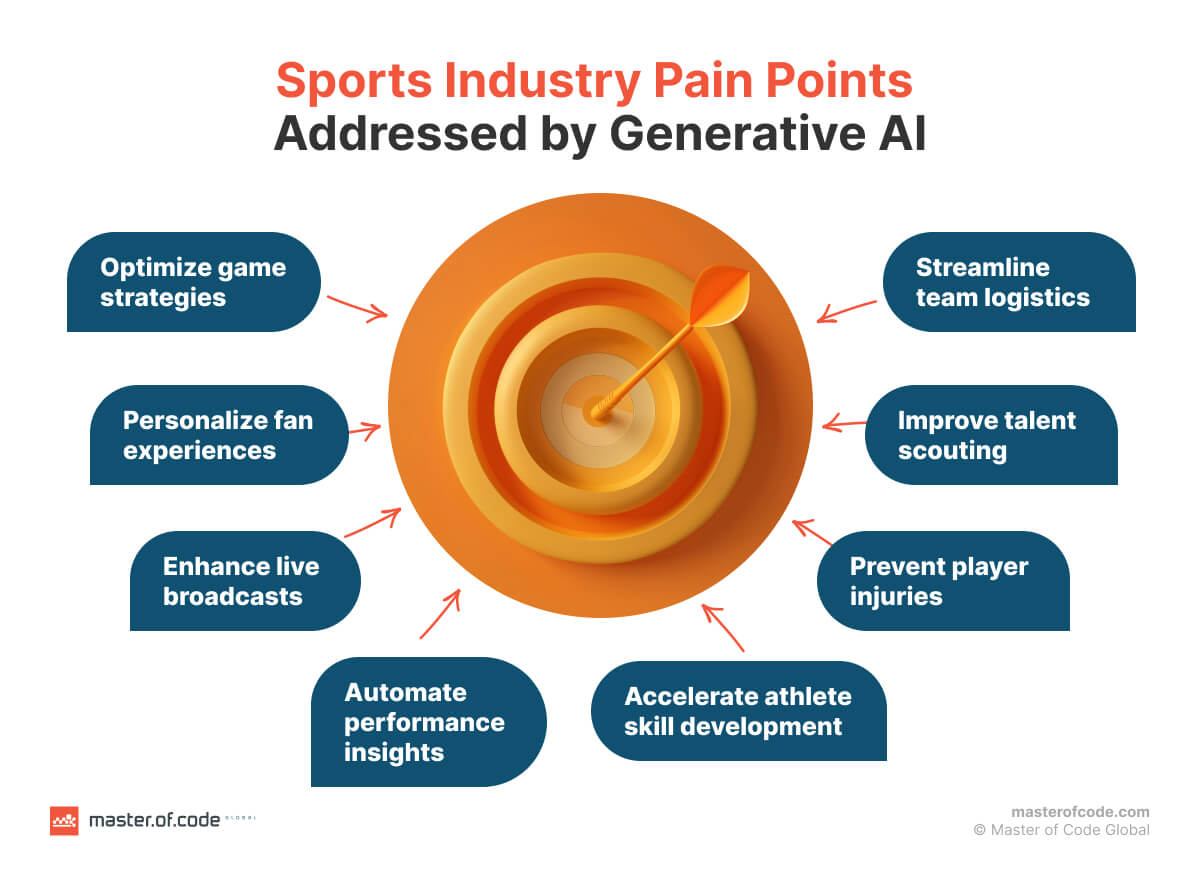
Scouting and Talent Identification
Finding the right sportsmen has always been part intuition, part data analysis. The process is faster, more objective, and more comprehensive with Gen AI. It processes vast datasets with game footage, performance metrics, and biometrics at a scale no human teams can match.
Possible applications include:
- Automated video analysis of matches across leagues and levels, highlighting players with specific skills or play styles that fit your needs.
- Predictive performance modeling using historical stats, growth curves, and injury history to forecast a player’s future potential.
- Global search that scans underrepresented or emerging markets, identifying promising athletes before they appear on mainstream radars.
Benefits:
- Faster, data-backed decisions without relying solely on subjective judgment.
- Lower acquisition risk by predicting performance trajectories and injury likelihood.
- Competitive edge through early identification of hidden talent pools.
Enhanced Player Performance Analysis
Improving player results depends on timely, accurate insights. It’s something Generative AI delivers by combining match footage, sensor data, and training logs into actionable feedback. This enables coaches and athletes to focus on what truly drives improvement instead of sifting through endless raw information.
Scenarios:
- Automated match breakdowns that identify successful plays, positioning errors, and missed opportunities, presented in a coach-friendly format.
- Biomechanical calculation using wearable and camera data to detect inefficiencies in movement, such as stride patterns or swing mechanics.
- Training plan optimization that adapts drills and workloads based on daily indicators.
Benefits for decision-makers:
- More effective coaching interventions guided by concrete, data-backed observations.
- Reduced risk of overtraining by balancing intensity with recovery needs.
- Higher individual and team performance through targeted skill development.
Before investing in development, conduct a focused AI readiness audit to uncover gaps in data quality, technical integration, or governance that could slow down adoption. From there, engage with experienced partners through Gen AI consulting services to assess feasibility, choose the right tech stack, and define measurable outcomes.
This combination of structured assessment and expert guidance ensures each initiative is designed for impact from day one, minimizing risk while positioning your organization to capture the full value of this technology.
Consideration #3: 5 Generative AI in Sports Case Studies
Concepts are valuable, but proof is better. These case studies highlight how top sports organizations are already using Gen AI with measurable impact at scale.
The International Olympic Committee (IOC) – Olympic Games Chatbot
Master of Code Global built a subscription-based Facebook Messenger bot for the IOC that delivered real-time medal updates, country-and-sport leaderboards, athlete Q&As, and behind-the-scenes content. By transforming Messenger into an interactive hub, fan interactions and platform usage surged, setting a new standard for digital engagement at major events. With the addition of Gen AI, the assistant could have evolved into a fully personalized companion.
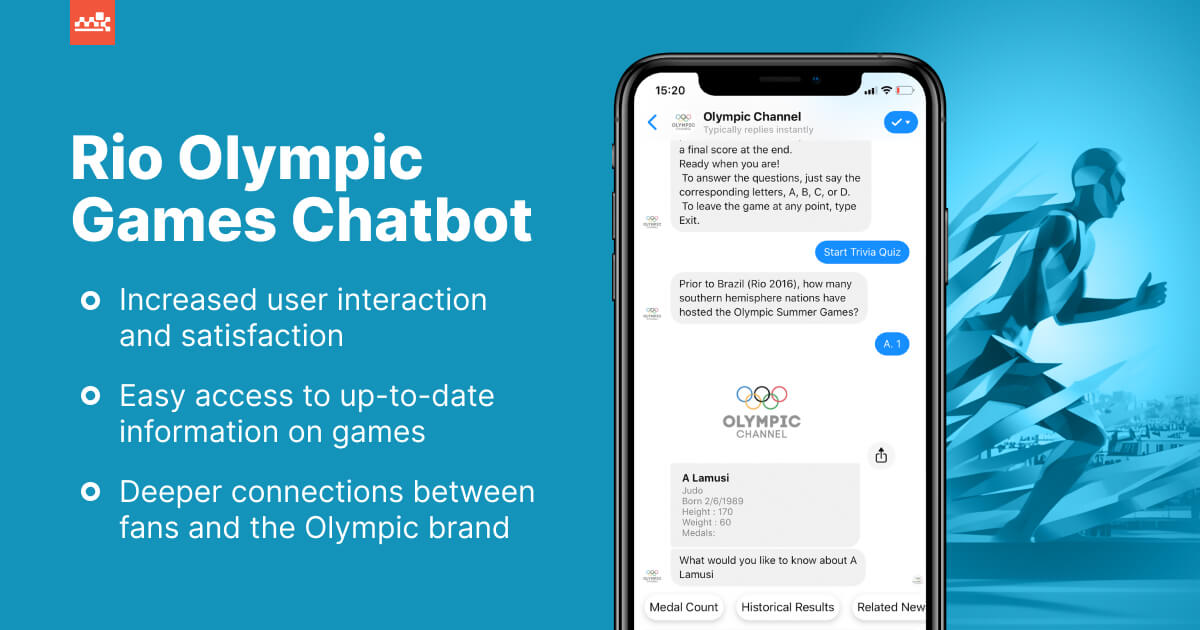
Scuderia Ferrari HP – Reimagined Fan App
Ahead of the Miami Formula 1 Grand Prix, Scuderia Ferrari HP and IBM launched a redesigned mobile app powered by artificial intelligence. It delivers AI-generated race recaps, post-race insights, strategy breakdowns, and interactive polls, plus fan-to-team messaging and personalized content journeys. Available in English and Italian, the app is a cornerstone in Ferrari’s tactics to create a more immersive, data-driven relationship with its global fanbase.
Williams Racing & Michelob ULTRA – “Lap of Legends”
This first-of-its-kind TV special pitted current driver Logan Sargeant against AI-based avatars of six F1 legends, recreated from decades of racing data and over 1,260 hours of footage. The combination of artificial intelligence, augmented reality, and precision simulation delivered a unique real-vs-virtual competition, deepening engagement and celebrating team heritage.
The National Football League (NFL) – AI-Powered Personalization
Through Adobe Platform, the NFL now personalizes touchpoints across all digital channels. The initiative empowers people to produce custom content, enhances live event experiences, and scales real-time creative output from over 140 on-field correspondents. It makes every interaction more personal and shareable.
The International Cricket Council (ICC) – AI Tournament Recaps
During the ICC Men’s Champions Trophy, fans receive bespoke “ICC Recapped” summaries of their game activity, from prediction accuracy to player votes. Such a smart approach boosts audience connection while driving repeat engagement across ICC digital platforms.
Warner Bros. (WBD) – Cycling Central Intelligence
For the WHOOP UCI Mountain Bike World Series, WBD and AWS launched an AI-powered platform that gives commentators instant, data-rich insights on riders, venues, and race histories. By streamlining research, the system enables richer storytelling and more engaging live coverage.
One key decision is whether to start with an out-of-the-box platform or invest in custom development. Ready-made tools can get you to market quickly, making them ideal for testing ideas or filling standard needs. However, they often have limits in scalability, data control, and feature flexibility. Custom-built solutions take longer to develop but give you full ownership, tailored capabilities, and the ability to evolve without vendor constraints.
Partnering with experienced Generative AI engineers ensures you choose the right approach for your goals. They can translate your vision into a production-ready solution, integrate it with your existing infrastructure, and design it to grow alongside your strategy, accelerating time-to-market without sacrificing long-term adaptability.
Consideration #4: Risk Factors When Deploying Artificial Intelligence
Generative AI in sports offers a clear upside, but its adoption isn’t without obstacles. Ignoring these can lead to stalled projects, wasted budgets, or even reputational damage. Executives should evaluate these threats early and have mitigation strategies in place.
Key challenges to address:
- Data privacy and compliance. Sports organizations collect sensitive data on athletes, fans, and operations. Without strict governance and adherence to regional regulations, AI projects can expose the business to legal and trust risks.
- Bias and accuracy. Language models trained on incomplete or skewed data can produce inaccurate predictions or unfair recommendations, undermining credibility.
- Integration complexity. New systems must connect seamlessly with ticketing, CRM, broadcast, and analytics platforms. Poor integration creates silos and undercuts ROI.
- Overreliance on automation. Without human oversight, Generative AI can make errors that affect live broadcasts, interactions, or strategic decisions.
- Cost creep. Licensing, infrastructure, and scaling costs can escalate if requirements aren’t clearly defined from the start.
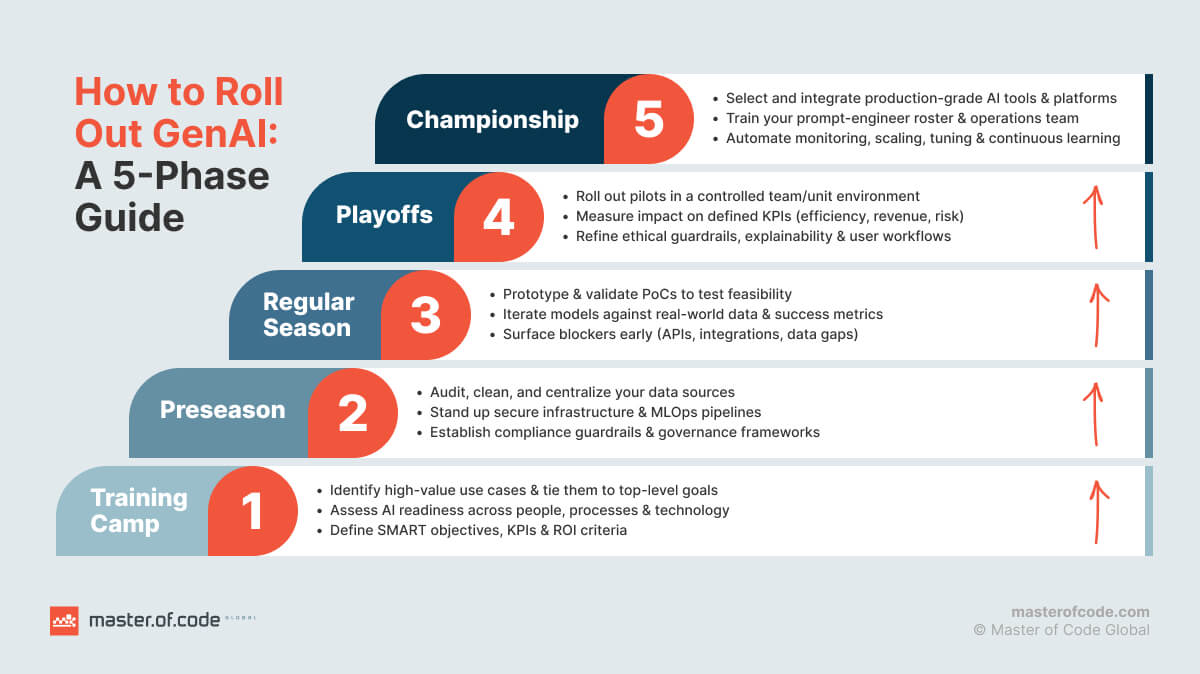
Why address these risks head-on:
- Higher trust and adoption among stakeholders, from fans to partners.
- Reduced implementation delays thanks to early technical and legal alignment.
- Sustainable ROI by avoiding costly rework or compliance fines.
- Start with a limited-scope rollout in a low-risk area (e.g., content personalization before live match decision support) to validate accuracy and stability.
- Keep human-in-the-loop oversight for high-impact outputs like injury forecasts or officiating assistance to prevent reputational damage.
- Establish compliance and governance protocols now; retrofitting them mid-season will slow you down and erode trust.
By treating risk management as an embedded part of your AI program, you don’t just avoid failures. You create a foundation that can scale safely across fan engagement, operations, and on-field performance.
Consideration #5: Preparing for the Future of Generative AI in Sports
Gen AI’s role in sports is still in its early chapters. Over the next 5–7 years, expect the technology to move from discrete applications to deeply integrated ecosystems that connect fans, athletes, and operations in real time.
Emerging directions to watch:
- Unified fan platforms. AI-powered hubs aggregating live stats, replays, merchandise offers, and community interaction in one personalized feed.
- Hyper-realistic simulations. Virtual matches against avatars of past or current players, fueled by decades of performance data.
- AI-assisted officiating. Systems that combine real-time video analysis with predictive modeling to support faster, more accurate decisions on the field.
- Adaptive training ecosystems. Fully customized athlete development plans updating daily based on biometric feedback, match performance, and mental wellness metrics.
- Immersive media formats. Generative AI creates multi-angle, interactive replays where viewers control the perspective or even alter game scenarios.
Wrapping Up: Turning “If” into “When”
Ultimately, Generative AI in sports is no longer a question of “if;” it’s a matter of “how” and “when.” From our discussion, the leaders who capture the greatest value share three practices:
- They begin with a clear, measurable business objective, rather than a vague technology goal.
- They tailor the solution’s scope and speed to their available resources, data readiness, and risk tolerance.
- They roll out in phased stages, validating impact early before expanding across the organization.
Putting these principles into action is smoother and more reliable with a seasoned partner. As a recognized leader in Generative AI development solutions, Master of Code Global brings a structured, transparent, and phased methodology to ensure your investment delivers genuine returns. If you’re ready to make artificial intelligence a unique selling point, let’s start the conversation.


